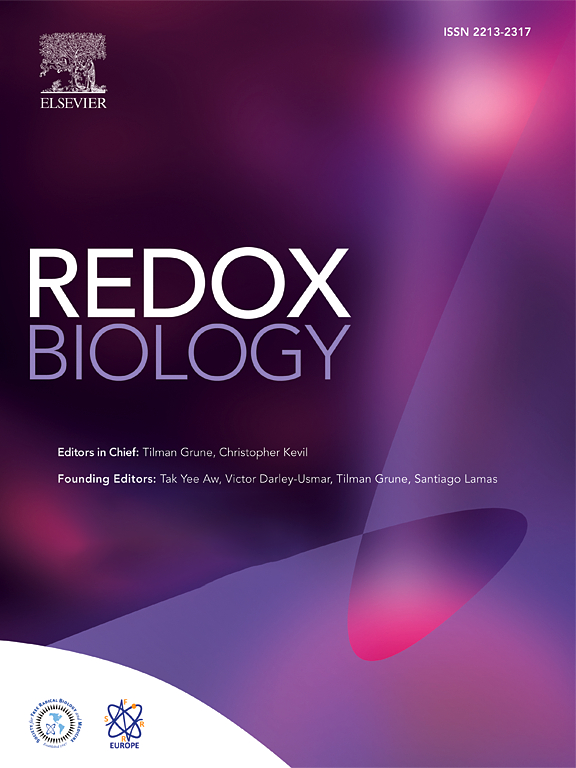Redox shuttle of cytosolic Thioredoxin to mitochondria protects against hyperoxia-mediated alteration of mitochondrial structure and dysfunction
IF 10.7
1区 生物学
Q1 BIOCHEMISTRY & MOLECULAR BIOLOGY
引用次数: 0
Abstract
Cytosolic thioredoxin (Trx) is a critical redox protein that converts protein disulfides to thiols via catalytic activity of thioredoxin reductase-1 (TrxR1) and NADPH. Thioredoxin-2 (Trx2) is a mitochondria-localized isoform. It is generally believed that Trx and Trx2 perform similar functions within the cytosol and mitochondria respectively. Here, we demonstrate that cytosolic Trx shuttles into mitochondria in the presence of normal levels of Trx2 in physiological state and higher levels of Trx translocate to mitochondria in oxidative stress conditions such as exposure to high concentrations of oxygen. This shuttle is required to maintain mitochondrial structure and function during physiological and oxidative stress conditions. Further, reduced Trx (Trx-SH) shuttle into mitochondria to protect against the downregulation of several mitochondrially coded genes and proteins of respiratory chain complexes in oxidative stress. Translocation of Trx occurs only in the reduced state as oxidized or cysteine mutant Trx is unable to translocate to the mitochondria. Accumulation of mitochondrial DNA damage product 8-Oxo-dG in hyperoxia is decreased in the presence of higher levels of cytosolic Trx within the mitochondrion. Collectively, our data demonstrate that shuttling of reduced cytosolic Trx into mitochondria protects against mitochondrial DNA damage, decreased gene and protein expression of respiratory chain complexes and mitochondrial dysfunction resulting in restoration of their native function and cell survival in physiological and oxidative stress conditions.
胞质硫氧还蛋白到线粒体的氧化还原穿梭可防止高氧介导的线粒体结构改变和功能障碍
胞质硫氧还蛋白(Trx)是一种关键的氧化还原蛋白,通过硫氧还蛋白还原酶-1 (TrxR1)和NADPH的催化活性将蛋白二硫化物转化为硫醇。硫氧还蛋白-2 (Trx2)是线粒体定位的亚型。一般认为Trx和Trx2分别在细胞质和线粒体内发挥类似的功能。在这里,我们证明了在生理状态下,正常水平的Trx会进入线粒体,而在氧化应激条件下,如暴露于高浓度氧气中,更高水平的Trx会转运到线粒体。在生理和氧化应激条件下,这种穿梭是维持线粒体结构和功能所必需的。此外,减少的Trx (Trx- sh)穿梭到线粒体中,以防止氧化应激中一些线粒体编码基因和呼吸链复合物蛋白的下调。Trx的易位仅发生在氧化或半胱氨酸突变的还原状态下,Trx无法转运到线粒体。高氧条件下线粒体DNA损伤产物8-Oxo-dG的积累随着线粒体内较高水平的胞质Trx的存在而减少。总的来说,我们的数据表明,在生理和氧化应激条件下,将减少的胞质Trx穿梭到线粒体中可以防止线粒体DNA损伤,减少呼吸链复合物的基因和蛋白质表达,以及线粒体功能障碍,从而恢复其天然功能和细胞存活。
本文章由计算机程序翻译,如有差异,请以英文原文为准。
求助全文
约1分钟内获得全文
求助全文
来源期刊

Redox Biology
BIOCHEMISTRY & MOLECULAR BIOLOGY-
CiteScore
19.90
自引率
3.50%
发文量
318
审稿时长
25 days
期刊介绍:
Redox Biology is the official journal of the Society for Redox Biology and Medicine and the Society for Free Radical Research-Europe. It is also affiliated with the International Society for Free Radical Research (SFRRI). This journal serves as a platform for publishing pioneering research, innovative methods, and comprehensive review articles in the field of redox biology, encompassing both health and disease.
Redox Biology welcomes various forms of contributions, including research articles (short or full communications), methods, mini-reviews, and commentaries. Through its diverse range of published content, Redox Biology aims to foster advancements and insights in the understanding of redox biology and its implications.
 求助内容:
求助内容: 应助结果提醒方式:
应助结果提醒方式:


